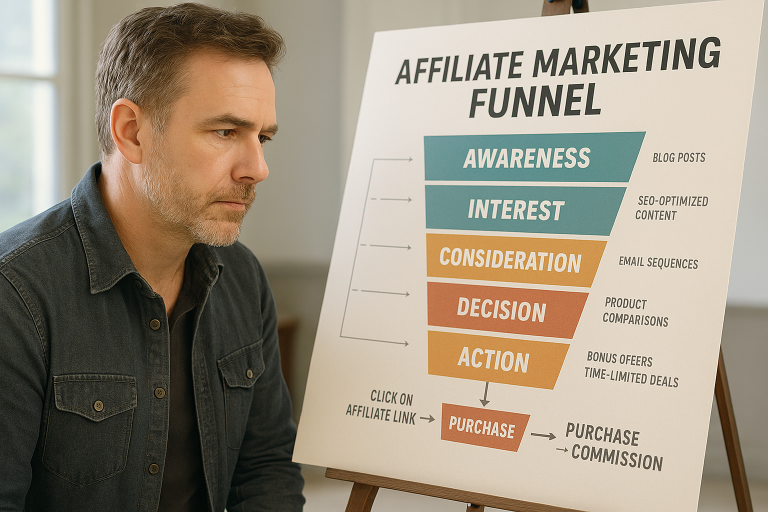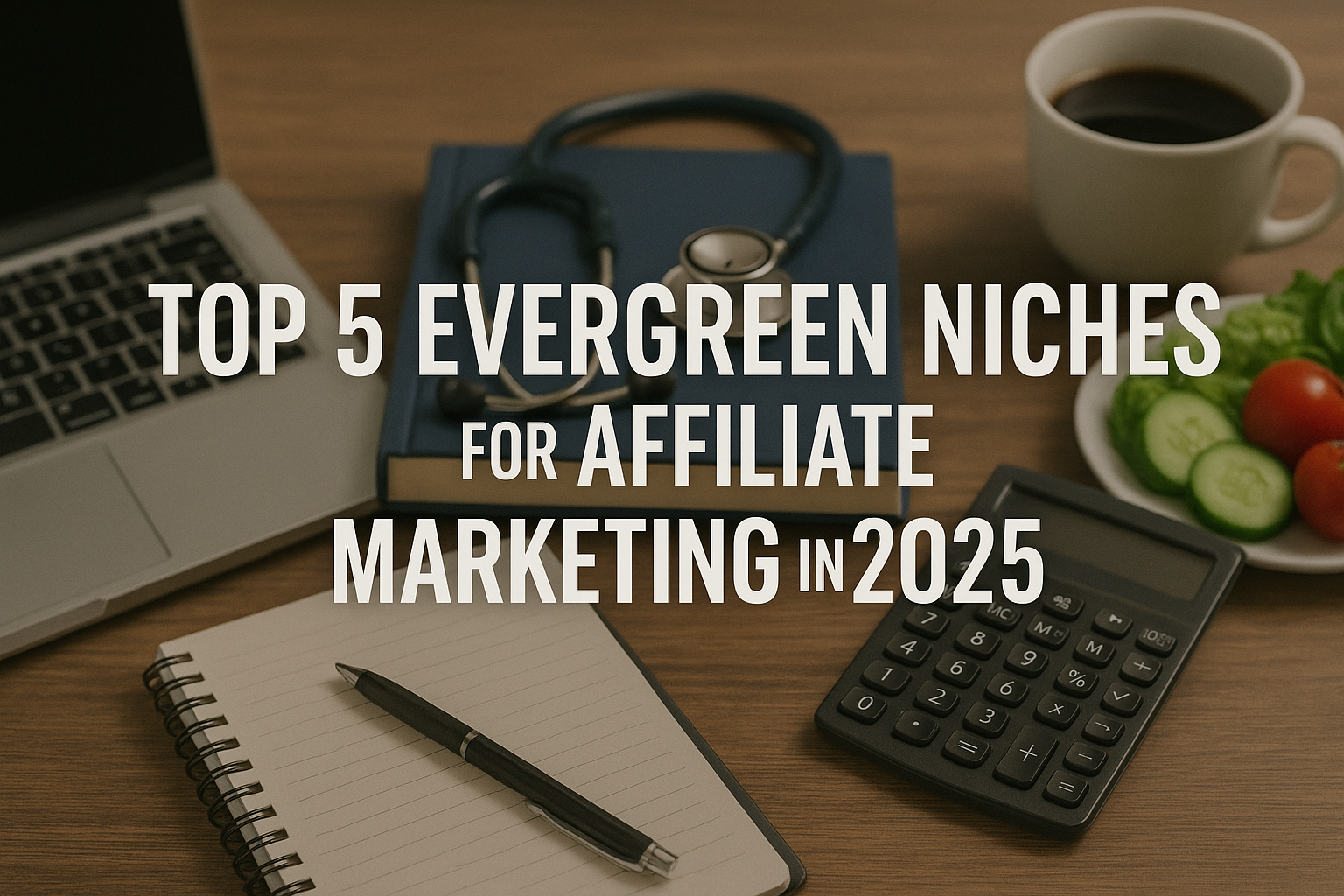The Affiliate Marketing Funnel Explained:
From Click to Commission
Picture this: You’ve just published what you think is the perfect product review. You’ve spent hours crafting every word, inserted your affiliate links strategically, and hit “publish” with high hopes. Days pass. Clicks trickle in. But commissions? Crickets.
Sound familiar? You’re not alone. Most affiliate marketers make the same critical mistake—they treat affiliate marketing like a light switch instead of a dimmer. They expect strangers to immediately trust their recommendations and whip out their credit cards after reading a single blog post.
But here’s the reality: successful affiliate marketing isn’t about pushing products—it’s about guiding people through a journey.
That journey is called an affiliate marketing funnel, and it’s the difference between earning pocket change and building a sustainable affiliate income. In this article, we’ll walk you through each stage of a successful affiliate marketing funnel, showing you exactly how to transform casual visitors into loyal customers who trust your recommendations.
For a comprehensive overview of affiliate marketing strategies, check out our complete affiliate marketing guide for 2025.
What Is an Affiliate Marketing Funnel?
Think of an affiliate marketing funnel as a GPS for your potential customers. Just as a GPS guides someone from their starting point to their destination through the most efficient route, your funnel guides visitors from their first interaction with your content all the way to making a purchase decision.
An affiliate marketing funnel is a step-by-step path that a potential customer follows from discovering your content to purchasing a product through your affiliate link. It’s called a “funnel” because, like its physical counterpart, it’s wide at the top (lots of people enter) and narrow at the bottom (fewer people convert, but they’re highly qualified).
The primary goal? Move cold traffic—people who’ve never heard of you before—toward a buying decision. But here’s what makes funnels so powerful: they don’t just increase conversions; they build trust. And in affiliate marketing, trust is everything.
Instead of bombarding strangers with sales pitches, a well-designed funnel nurtures relationships. It provides value first, builds credibility over time, and positions you as a trusted advisor rather than just another marketer pushing products.
The 5 Key Stages of the Affiliate Funnel
1. Awareness (Top of Funnel)
Objective: Attract attention and get on people’s radar
This is where everything begins. Your potential customers have a problem, but they might not even realize it yet—or they’re just starting to look for solutions. Your job at this stage isn’t to sell anything. It’s simply to be found when people are searching for information related to your niche.
Effective tactics include:
- Blog posts that answer common questions in your niche
- SEO-optimized content that ranks for keywords your audience searches for
- YouTube videos that provide tutorials, reviews, or insights
- Social media posts that spark conversations and provide value
The key here is volume and visibility. You want to cast a wide net and be present wherever your target audience hangs out online. For example, if you’re in the fitness niche, you might create blog posts about “best home workouts,” YouTube videos reviewing fitness equipment, and Instagram posts sharing quick workout tips.
Essential tools for this stage:
- Keyword research tools like Ahrefs or Ubersuggest to find what your audience is searching for
- Social media scheduling tools to maintain consistent presence
- Analytics tools to track which content performs best
2. Interest
Objective: Engage visitors and turn them from browsers into subscribers
Congratulations! People found your content. But here’s where most marketers drop the ball—they let these visitors slip away without capturing their contact information. The interest stage is about engaging people deeper and getting permission to continue the conversation.
This is where lead magnets become your best friend. A lead magnet is something valuable you offer for free in exchange for an email address. The key is making it so useful that people would happily pay for it.
Winning tactics include:
- Free guides or checklists that solve a specific problem (like “The Ultimate Keyword Research Checklist”)
- Content upgrades that complement your blog posts (a downloadable PDF version of your post, bonus tips, templates)
- Quizzes or surveys that provide personalized results
- Mini-courses delivered via email
For instance, if someone reads your blog post about “How to Start a Blog,” your lead magnet might be a checklist called “Blog Launch Checklist: 27 Steps to Go Live in 24 Hours.”
Must-have tools:
- Email opt-in form builders like MailerLite or ConvertKit
- Landing page builders to create dedicated pages for your lead magnets
- Quiz builders if you’re using interactive content
3. Consideration
Objective: Build trust and position yourself as the go-to expert
Now you have people’s email addresses, but they’re still not ready to buy. They’re in research mode, comparing options, reading reviews, and trying to make the best decision. This stage is all about nurturing the relationship and proving that you understand their needs.
Your email sequences during this stage should focus on education, not selling. Share case studies, provide detailed product comparisons, and tell stories about your own experiences. The goal is to become the trusted voice they turn to when they’re ready to make a decision.
Powerful tactics include:
- Email sequences that provide valuable tips and insights over several days or weeks
- Product comparison posts that objectively analyze different options
- Case studies showing real results from products you recommend
- Behind-the-scenes content that builds personal connection
For example, if you’re in the email marketing space, you might send a 7-part email series comparing different email platforms, sharing your personal experience with each, and providing specific use cases for different types of businesses.
Key tools:
- Email autoresponders to deliver sequences automatically
- Affiliate link cloakers to make your links look professional
- Review templates to ensure you cover all important points consistently
4. Decision
Objective: Create urgency and trigger action
Your subscribers are now educated and engaged, but they’re still sitting on the fence. The decision stage is about giving them that final push—providing compelling reasons to act now rather than later.
This isn’t about high-pressure sales tactics. It’s about removing friction, addressing final objections, and making the decision feel like a no-brainer.
Conversion-focused tactics:
- Exclusive bonuses available only through your link (bonus courses, templates, or consultations)
- Time-limited deals that create genuine urgency
- Clear, compelling calls-to-action that tell people exactly what to do next
- Social proof like testimonials or user counts
For instance, you might offer a bonus course worth $200 for anyone who purchases through your link within the next 48 hours, along with a personal email offering to answer any questions they have about the product.
Essential tools:
- Countdown timers to create visual urgency
- Click tracking tools like Pretty Links or ThirstyAffiliates to monitor performance
- Bonus delivery systems to fulfill your promises automatically
5. Action (Conversion)
Objective: Secure the sale and earn your commission
This is the moment of truth. Your carefully nurtured lead clicks your affiliate link, lands on the merchant’s sales page, and makes a purchase. Congratulations—you’ve earned a commission!
But smart affiliate marketers know the relationship doesn’t end here. The action stage is also about maximizing the value of each customer and setting the stage for future conversions.
The conversion process looks like this:
- Visitor clicks your affiliate link
- They’re redirected to the merchant’s sales page
- They complete the purchase
- You earn a commission
- You follow up to ensure satisfaction and introduce related products
Important tools:
- Affiliate dashboard analytics to track conversions and commissions
- Retargeting pixels to create audiences for future marketing
- Thank you pages to deliver bonuses and set expectations
Optimizing Your Funnel
Creating a funnel is just the beginning. The real magic happens when you start optimizing each stage based on real data. Think of your funnel as a living, breathing system that gets better with time.
Track performance at every stage. Use Google Analytics to see where people drop off, monitor your email open and click-through rates, and analyze your affiliate dashboard data to understand which products convert best. Every piece of data tells a story about what’s working and what isn’t.
Split test everything. Try different headlines, test various lead magnets, experiment with email subject lines, and compare different calls-to-action. Even small improvements can compound into significant results over time.
Improve your follow-up sequences. If your email open rates are low, work on better subject lines. If people aren’t clicking your links, focus on providing more value in your emails before making recommendations.
Use retargeting ads strategically. Not everyone will join your email list on their first visit. Retargeting ads can bring back interested visitors and give you a second chance to capture their attention.
Common Funnel Mistakes to Avoid
Even with the best intentions, it’s easy to sabotage your own funnel. Here are the most common mistakes that kill conversions:
Skipping the nurture phase. The biggest mistake? Trying to sell too early. Sending someone straight from a blog post to an affiliate offer is like proposing on the first date. Build the relationship first.
Creating confusion with too many options. Don’t overwhelm people with multiple links, competing calls-to-action, or too many product recommendations at once. Give clear, singular direction at each stage.
Failing to segment your audience. Not all traffic is created equal. Someone who found you through a “beginner’s guide” article has different needs than someone who discovered you through an advanced tutorial. Tailor your messaging accordingly.
Neglecting follow-up. Many sales happen on the second, third, or even tenth touchpoint. If you’re not following up with people who didn’t convert initially, you’re leaving money on the table.
Your Next Steps
Building an affiliate marketing funnel isn’t just about making more money—it’s about creating genuine value for your audience while building a sustainable business. When you guide people through a thoughtful journey instead of pushing products, everyone wins: your audience gets better recommendations, merchants get qualified customers, and you earn commissions from people who truly trust your advice.
Take a moment to map out your current funnel. Where are the gaps? Which stages need the most attention? Start with one improvement at a time, test your changes, and build from there.
The most successful affiliate marketers understand that funnels aren’t just marketing tools—they’re relationship-building machines. Focus on serving your audience at every stage, and the commissions will follow naturally.
Ready to build your first high-converting funnel? The framework is in your hands. Now it’s time to put it into action and start transforming those casual visitors into loyal customers who trust your recommendations.




